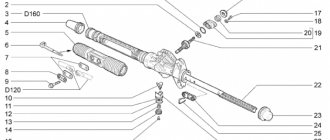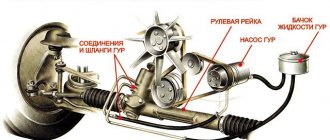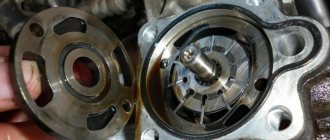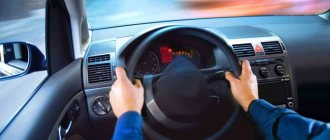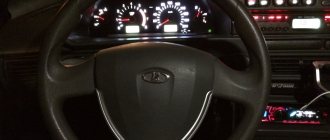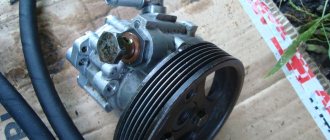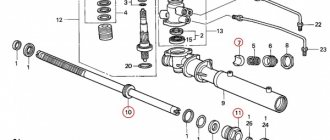In this article we will figure out why a knocking sound is heard when turning the steering wheel in place or while the car is moving. Let's find out the main causes and methods for eliminating them.
Author: Raul_ HF and wheel alignment mechanic; experience - 3 years. Service/repair consultant at Toyota DC; experience - 4 years.
The steering rack is a simple design and fairly reliable unit, which is why today it is used on the vast majority of cars. The wheels turn by moving the rod, which moves the steering rods connected through ball joints to the wheel hubs. The rod has teeth that mesh with the worm gear. The actuator worm mechanism receives rotation from the steering wheel through a system of shafts and cardan joints. Since the entire steering mechanism is subjected to significant stress, parts and components naturally wear out over time. As a result, free play or play is formed in the connections, which can usually manifest itself in the form of knocking noises when driving over uneven surfaces or when turning the steering wheel.
Knocking noise when turning the steering wheel
Thanks to hydraulic or electric power steering, which acts directly on the rod when turning the steering wheel, the main load on transmitting rotation is removed from the steering drive. This significantly extends its service life, however, the component components are also subject to wear and tear over time. A knocking sound when the steering wheel rotates in place is in most cases associated with wear of the crosspieces or splined joints of the steering rack drive shaft.
The crosspieces contain roller bearings. Exhausted rollers cause “biting” of the universal joint. This manifests itself in the form of knocking noises when the steering wheel is turned without the car moving.
The following possible causes are not related to the steering. When turning the steering wheel to the left or right, the CV joint may bite and make a knock if the joint is faulty. For example, damaged by corrosion due to dirt and moisture after driving with a torn boot, or as a result of wear and tear. When you start driving with the wheels turned, knocking noises from the rotation of a faulty drive under load are especially obvious.
Knocks when turning the steering wheel can be caused by a violation of the integrity of the strut spring. For example, a broken coil when turning a wheel touches body elements.
Front suspension repair
The cost of the parts themselves when eliminating the described reasons is most often small, but the price of replacing them in car services sometimes causes bewilderment. In such cases, it is better to repair the suspension yourself. This requires special devices and tools.
To remove the tips and ball joints of the steering wheel, pullers are needed that, during dismantling, preserve the integrity of these parts.
Silent blocks are replaced using a long threaded rod or bolt with a corresponding nut and a set of bushings and washers. The bushings should rest on the lever cage, and the washer should match the diameter of the rubber seal. Tightening the nut squeezes the silent blocks out of the lever, and then presses a new one in its place.
Dismantling the shock absorber strut is done with two ties that compress the spring. This makes it possible to unscrew the mounting bolts, remove the support bearing and remove the shock absorber and spring. The new spring is also completely compressed by the ties, then the entire assembly is assembled.
A knock when turning the steering wheel should not make the driver nervous. However, as soon as you have time, you should immediately start troubleshooting the problem. Today on the Internet you can find videos from professional craftsmen and amateurs about repairing suspensions of different car models and for various malfunctions. It is better to spend time studying their experience and then repair everything efficiently and quickly.
In this article we will figure out why a knocking sound is heard when turning the steering wheel in place or while the car is moving. Let's find out the main causes and methods for eliminating them.
Author: Raul_ HF and wheel alignment mechanic; experience - 3 years. Service/repair consultant at Toyota DC; experience - 4 years.
The steering rack is a simple design and fairly reliable unit, which is why today it is used on the vast majority of cars. The wheels turn by moving the rod, which moves the steering rods connected through ball joints to the wheel hubs. The rod has teeth that mesh with the worm gear. The actuator worm mechanism receives rotation from the steering wheel through a system of shafts and cardan joints. Since the entire steering mechanism is subjected to significant stress, parts and components naturally wear out over time. As a result, free play or play is formed in the connections, which can usually manifest itself in the form of knocking noises when driving over uneven surfaces or when turning the steering wheel.
Knocks when turning the steering wheel while driving
When a wheel hits a sharp bump, the joint, which has lost its rigidity, produces a characteristic knock due to the gap. The problem is resolved by searching for the faulty part, replacing it or repairing it. Knocks when turning the steering wheel while driving on uneven surfaces may indicate probable wear of the following components and elements:
- steering rack mechanism
- steering rods
- steering tips
- rack housing fastenings
- ball joints
- shock absorbers
- anti-roll bar bushings
To restore the power steering rack, special repair kits are provided, which include a set of seals, oil seals and bushings. A high-quality overhaul and correctly adjusted unit will return it to almost its original condition, at an adequate cost for labor and spare parts. Due to the complexity of their design, many electrically driven racks cannot be disassembled or repaired. If an internal fault is diagnosed, this expensive unit is replaced only as an assembly.
A knocking noise when turning the steering wheel left or right on the road can be caused by a worn-out shock absorber. The shock absorption efficiency of a worn or leaking suspension damping element is significantly lower than normal, and when receiving load as a result of body roll in turns, on bumps and potholes, such a shock absorber “breaks through.” If MacPherson struts are installed on the front suspension, the bearing of the support cup may also produce a knock when cornering.
The cause of a knocking sound when turning the steering wheel in motion can be wear of the rubber clamps and bushings through which the rack body is attracted to the body or subframe. At the same time, the rack is not rigidly fixed, but “dangles” in its fastenings and knocks when the steering wheel is turned to the right or left, as well as when driving over bumps and holes. The same applies to worn-out SPU bushings, which are not able to tightly hold the stabilizer rod, causing it to move, vibrate and knock due to increased free play.
If you hear a noticeable knocking noise when you move the steering wheel left to right: diagnosis
Probable Causes
If an audible knocking sound in the front suspension when turning the steering wheel indicates wear in its constituent parts, then an extraneous clicking sound when the steering wheel rocks requires inspection of other structural elements. As a rule, the problem lies in the vehicle control system.
Statistics show that there is something to knock in the “steering wheel”. Any pairing may come under suspicion:
- Gap in the fit between the steering tip and the strut.
- Excessive play in the steering rack.
- There is a problem with the steering shaft driveshaft.
- Free movement of the steering wheel on the shaft.
- Gap in steering rod joints.
These parts are present in the design of any car. Knowing the location of all the landings, it remains to identify the defective pair.
For your information. Some old foreign cars have a folding steering column assembly, which breaks under the influence of a critical load that occurs during an accident. He can knock too.
How to identify knocking: expert methods
The classic approach to identifying a faulty unit will be explained in any garage. Its essence is trivial: just ask the assistant to shake the steering wheel and at this time put his hand on the mentioned connections.
Steering rack
However, in some situations this technology loses its relevance. In particular, it will not be possible to identify a defect in the mechanism using this method. To identify a problem in the gear-rack engagement, it is necessary to carry out the following experiment:
- If there is power steering (hydraulic booster): a knocking sound appears when the steering wheel is rotated on a car with the engine turned off, but when the engine is running, there is no knocking at the place.
- There is no power steering: drive along a road section with a changeable direction - when you swing the steering wheel left to right, a knock is heard, but when turning, the rack does not knock due to the small wear of the working surfaces of the gearing in the extreme positions.
For your information. It is not recommended to tighten a worn rack. One of the owners of Hyundai Solaris performed this procedure and after 10,000-12,000 km the steering wheel began to bite. An autopsy showed that the mechanism was beyond repair.
Emergency system
It is also possible to determine experimentally whether the steering column folding assembly is the cause of the knocking. It is enough to swing the “steering wheel” to the sides, while simultaneously pressing it to the bottom. The sound disappeared - the problem is in the emergency system.
Knock in the steering wheel on uneven surfaces when driving straight ahead
In cases where knocking is heard on the steering wheel when driving over uneven surfaces, this may indicate wear on the bearings of the steering column shaft located in the cabin. This malfunction causes radial play of the shaft, accompanied by knocking. Axial play of the shaft is also possible due to wear of the locking or sealing rings. In some cases, manufacturers provide the supply of spare parts for inexpensive repair of the dispenser. During the overhaul, related parts, fastening and sealing elements are also replaced, which may still be in working order, but may soon fail and require repeated repair of the unit. On a number of models where disassembly and restoration are not provided, the steering column is replaced as an assembly.
Ball joint - knocking in the suspension of different characters
There is a part in the car suspension that is difficult to check. If it knocks, it happens precisely on small and unnoticeable irregularities. The ball loses its lubricant and begins to move very difficultly inside the seat. This causes sounds like creaking, light knocking, and annoying rattling. An element fails for the following reasons:
- just natural wear of the part, which occurs every 100,000 kilometers; during operation, the mechanism wears out, lubricant comes out, and efficiency decreases;
- the support begins to knock quite unexpectedly, the intensity of the sounds quickly increases, so it is better to promptly replace the element;
- when installing a low-quality support, a not very pleasant process occurs - after a few thousand kilometers, extraneous sounds appear that are unpleasant to listen to;
- Also, a torn boot is one of the main causes of problems in this part of the car, so you should constantly look at the rubber bands and their integrity.
Causes of knocking noise when turning the steering wheel
There are a number of reasons why a knock is heard when turning the steering wheel. To more accurately determine the malfunction, it is necessary to determine three circumstances:
- Sound type. It can be single or repeated, voiceless or voiced (usually metallic), loud or quiet.
- The place from which the sound comes. For example, in the wheel, in the suspension, in the steering wheel.
- Circumstances of occurrence. In particular, when driving, when turning the steering wheel in place, when the steering wheel is turned all the way, when turning left or right.
Based on such data, you can focus on the source of the knocking sound.
| Place of knock | Causes of knocking |
| Knocking in the wheel | Partial failure of the angular velocity joint (the boot is torn, problems with the bearing), noise from tie rods/steering rods, steering rack when driving on rough roads, shock absorber struts (spring knocking), stabilizer struts |
| Rack knock | Damage to the rack shaft, increased play of the bushing and/or shaft bearings, on machines with electric power steering, mechanical damage to the engine shaft and/or worm drive, wear in the steering shaft driveshaft |
| Knocking in the steering wheel | Partial failure of the steering rack, rusting of the rack drive shaft, wear of the worm drive in the EUR and/or mechanical problems with the electric motor |
| Steering wheel position | Causes of knocking |
| When turning the steering wheel all the way (left/right) | When replacing the front control arm, it is possible that the lever hits the subframe when turning. Sometimes craftsmen simply do not fully tighten the fasteners, which cause them to creak when turning. |
| When turning the steering wheel while the car is stationary | Faulty steering rack, universal joint, loose fasteners, tie rods/ends |
| When turning the steering wheel while the car is moving | The same reasons as when the car is stationary, but problems with stabilizer struts and shock absorber struts are added here. |
Below is a list of reasons why knocking occurs when turning in the area of the wheel, suspension and steering wheel, according to the degree of their prevalence.
Causes of knocking and their elimination
If you correctly determine the cause, then by acting on it, you can eliminate the malfunction with a certain accuracy.
I offer a specific list of causes of knocking and their elimination:
- Increased free play of the steering wheel. Possible due to gaps in the hinge joints of the rods, the rack and gears are not adjusted in engagement or the steering bipod mount is not securely installed. How to determine? You can alternately steer left and right and check the steering joints and connections at the same time.
The axial movement of the steering wheel can be determined by grasping the steering wheel with both hands and alternately moving it toward and away from you; there is no need to turn it. You will need to check the ball joints, if there is play, replace the tips. To avoid missing anything, tighten the tie rods to the bracket, check the condition of the rubber hinges, the fastening of the bolts, and adjust the bearings. - Knocking or noise in the steering column - again due to loosening or deformation of certain parts; in the absence of lubrication or insufficient working fluid in the steering gear housing. How to fix the problem? I tighten the fastening, replace parts that have undergone deformation, install retaining rings, add or check the fluid level, and check the condition of the oil seal.
- Knocking or noise in the steering - this can only be determined when you are able to steer the car. The ball joint nuts may have become loose or the gap between the rack stop and the nut may have increased. This can also happen when the entire system is weakened. What to do? I replace parts that have worn out, tighten the steering gear nuts and tighten the bolt securing the lower coupling flange.
- The steering wheel moves on the shaft - this is due to the loosening of the fastening nut; you just need to tighten it.
- Oil is leaking from the crater - the bipod shaft seal may be deformed or worn out, in which case the seal will need to be replaced.
Constant-velocity joint
With the wheels turned completely to one side, the CV joint will most often creak (it may even give impacts to the steering wheel). When turning the car to the left, the right outer CV joint will crunch/knock, and when turning to the right, the left one will, accordingly. Inner CV joints usually creak when driving at high speed on uneven roads, so they have nothing to do with knocking when turning. So if you hear a knocking sound when turning or sharply accelerating your car, the outer joint most likely needs to be replaced. However, first you can remove it and inspect it - if there is no wear or it is small, then CV joint lubrication will help.
Messages 14
1 Topic by Alternative 2016-04-06 12:45:33
- Alternative
- Participant
- Inactive
- Registration: 2016-04-06
- Messages: 99 Thanks : 14
- Car: VAZ 2110
Topic: Resolved: Rapid knocking of the front wheel when turning on a bad road
Good afternoon. Help is needed! While driving (no matter what speed), rapid knocking noises are heard from the driver's front wheel. They happen when turning to the right; you turn the steering wheel literally a couple of centimeters to the right, and it starts to rattle. And this happens on a rough road, nothing happens on a smooth one. Car 2007 VAZ 2110
2 Reply from Denis Artyukhov 2016-04-06 22:56:06
- Denis Artyukhov
- Local
- Inactive
- From: Penza
- Registration: 2015-10-21
- Messages: 1,390 Thanks : 278
- Car: VAZ 21124
Re: Resolved: Rapid knocking of the front wheel when turning on a bad road
Look at the anthers on the CV joint.
3 Reply from Alternative 2016-04-06 23:41:55 (2016-04-06 23:42:08 edited by Alternative)
- Alternative
- Participant
- Inactive
- Registration: 2016-04-06
- Messages: 99 Thanks : 14
- Car: VAZ 2110
Re: Resolved: Rapid knocking of the front wheel when turning on a bad road
I went to a hundred in my city, they said I needed to change the CV joint and ball joint, in the end I wasted my money (although it might come in handy in the future), well, I changed everything myself, because... Replacing these two things would cost 1,500 rubles, the problem remained and nothing changed. I just want to find out what exactly the problem might be, having looked around here, I most likely found what the problem is, maybe the strut support bearing =) I think that’s where the problem lies, because... seems to be knocking from there)
The good condition of the steering system is the key to safe maneuvers on the road. Excessive play in the vehicle's front axle control mechanisms is unacceptable. They cause a slow response to sharp turns of the steering wheel, which is unacceptable in emergency situations. Driving a car with problems in the main unit that sets the motion vector is prohibited both for ideological reasons and in accordance with traffic rules.
Tie rods and tie rods
Due to natural wear and tear, the lugs and rods may, over time, become loose and squeak and make knocking noises when turning the machine. To diagnose, you need to jack up the car on the side where the annoying sound is coming from and first remove the wheel. Next, you need to shake the rods and tips and check for any play in them. It often happens that the boot on the tip breaks, which means dirt and moisture gets inside. This causes a corresponding knock.
There are cases when, for example, when performing a wheel alignment operation, a car enthusiast or master forgets to tighten the fastening nut between the steering rod and the steering tip. Accordingly, when you turn the steering wheel, both in motion and at a standstill, a loud metallic knock will be heard. You can determine more precisely if you shake the front wheel left and right with your hands, it will dangle and make similar sounds.
Quick Guide
The main reason for tapping is the formation of a gap in the joints. In the steering system, there may be knocking on the tips, ball joints of the rods, the rack, the “cardan” in the column, the steering wheel on the shaft, or the auto-folding system in case of an accident. The metallic sound is distinct and can be heard in place when rocking the steering wheel.
It is quite possible to mistake problems in the suspension for problems in the steering, since the initial stages of wear of bearings and supports only make themselves felt when cornering at speed. In the suspension part, the cause of the knock should be sought in the wheel bearings, ball joints and “supports”.
Often, motorists operating domestically produced cars are faced with a rather unpleasant problem, characterized by a knocking sound at the bottom of the front part of the vehicle when the steering wheel is turned. The first solution that comes to a car enthusiast’s mind is to contact a specialized car service center. However, it has several significant disadvantages. For example, there is no guarantee of a positive result or significant financial costs. That’s why we recommend trying to figure out the problem yourself.
Steering rack
Steering rack malfunctions are one of the most common causes of knocking noise when turning wheels. Moreover, this can happen both while moving and when turning the steering wheel in place. There are several reasons why a car's steering rack may knock:
- Loose steering fasteners.
- The plastic support sleeve has failed (considerably worn out, play has appeared).
- The occurrence of play in the rack shaft bearings.
- Increased gap between the teeth of the steering rack (this leads to both play and a dull knock when the steering wheel rotates in place).
- The anti-friction gasket wears out, causing the clamping “cracker” to vibrate, knocking directly on the rack body.
Description of the problem
Many drivers have experienced a sudden knocking sound when turning the steering wheel. It can even arise from a small stone that accidentally falls on the subframe. But such situations arise infrequently. Most malfunctions are somehow related to the operation of the steering system. In addition, knocking is possible due to an incorrectly installed element inside this system. Don't wait for the sound to disappear on its own. The knocking noise should be eliminated immediately after it appears, since any malfunction negatively affects the safety of driving the car.
The steering system keeps the car under control while driving. If it does not function correctly or has malfunctions, this will soon lead to an accident. The driver needs to regularly undergo vehicle inspection, not forgetting to pay attention to control diagnostics.
We list a few “symptoms” that are guaranteed to indicate a problem with the steering wheel:
At the beginning of the drive, especially in winter, the driver feels how difficult it is for him to turn the steering wheel. As he tries to turn, he hears the wheels making a noise. All these signs may indicate defects in the power distributor, or a broken belt and wear on the power steering pump.
There is a knocking sound coming from the front suspension, it intensifies when you turn the steering wheel, and becomes louder when driving on uneven surfaces. As a result, the car becomes difficult to control.
A strong backlash occurs, somewhat reminiscent of chattering. The car stops responding to turns.
Oil leakage is a common symptom that makes itself felt every day. Puddles of oil appear under the hood in different places.
In order to independently diagnose the problem, the driver needs to know exactly what type of steering rack is installed in the car. They are divided into mechanical, hydraulic and electrical. Each type requires special attention; to check the last two, the driver will need certain equipment.
Steering cardan
If, when turning the steering wheel, you hear a knocking sound from the steering column, then the steering wheel shaft driveshaft is most likely to blame. Very often UAZ owners face this problem. A malfunction occurs due to an increase in the gap in the spline joint. On VAZs, a knocking sound from the steering column occurs due to a broken universal joint. It can be heard both while driving and when turning the steering wheel back and forth in place.
Many owners of domestic front-wheel drive VAZs - “Kalinas”, “Priors”, “Grants” - are faced with the fact that over time the crosspiece in the driveshaft begins to creak. Its diagnosis is carried out according to the procedure described above. If play and creaking are detected, the car owner can choose one of two options. The first is to buy a new cardan, the second is to try to repair the installed one.
Moreover, they are repaired not because of the high price, but because of a large number of defective new cardan shafts. In particular, we are talking about the fact that the cardan can “bite”. This is caused by the fact that its half with splines moves with jamming, and jerks are already felt in the new part. Accordingly, when purchasing a new crosspiece, you need to make sure that it moves freely in all directions. It often happens that in a fork with splines, the bearings are initially skewed due to misalignment of the holes. Therefore, it is up to the car owner to decide whether to buy a new cardan or not.
Another way out of the situation is to replace the existing needle bearings in the cardan crosspiece with caprolactane bushings. This option is supported by the fact that many taxi drivers who own VAZs, due to the fact that they have to turn the steering wheel a lot, do exactly this.
This option implies the complexity of repair work. As for dismantling, they usually use 13mm wrenches and a flat-head screwdriver.
On the Internet you can find many conflicting reviews about various cardan shafts and bushings. For VAZ “Kalina”, “Priora”, “Granta” cars, crosspieces of the “CC20” and “TAYA” brands are often installed, or a more expensive option is Japanese spare parts Toyo and GMB.
Shock absorber struts and/or support bearings
If the cause of the knocking lies in the shock absorbers or support bearings, then there will be knocking not only when turning the steering wheel to the right/left, but also when driving in a straight line. However, during sharp turns, especially at high speed, such a knock will be more pronounced, since additional loads will be applied to the shock absorbers and bearings.
In the latter case, the cause of the knock may be a broken shock absorber spring. This usually happens at its edges (top or bottom). Accordingly, when driving on uneven roads, as well as when the car rolls in turns, the driver may hear a metallic clanging sound. When turning left - right spring, when turning right - left spring.
You can check the shock absorbers and bearings by examining them for play. To do this, you need to dismantle the wheel and shake/twist the shock absorbers and bearings. In rare cases, the knocking noise may be caused by a loose fastening nut.
Front stabilizer
If the stabilizer link partially fails, a dull knock is heard when the wheels turn while moving. Moreover, the wheels begin to knock if they are turned to one side or the other at approximately 50...60%. However, a faulty strut itself can creak not only when turning, but also when the car is moving on an uneven road. Often the car also “fidgets” on the road, that is, it is necessary to constantly control (twist) the steering wheel. Additional signs - the car body rolls too much when entering a turn and sways when braking.
Subframe (atypical situations)
Sometimes atypical situations that are quite difficult to diagnose lead to knocking when turning. For example, there is a known case when, while the car was moving, a small stone hit the subframe and got stuck there. When you turn the steering wheel in one direction or the other, a natural displacement of the steering gear elements occurs, and they seem to run over this stone. When the elements were restored to their original position, they jumped off the stone, making a characteristic sound. The problem was solved by removing the stone.
When repairing suspension elements, for example, when replacing the front arm, the latter may touch the subframe when turning the wheel. Naturally, this is accompanied by a blow and a grinding sound. To get rid of it, it was enough to lift the subframe using a pry bar.
content .. 8 9 10 11 ..Lada Priora (2013+). Knocking and clicking noises when turning the car
| Lack of lubrication in the joint | Inspect the case. Remove the drive and check the hinge. Apply sufficient new lubricant to the joint and replace the damaged joint cover. If there is play, replace the hinge or drive assembly |
| The intermediate bearing is severely worn | Remove the intermediate support bracket and check the play in the bearing. If necessary, replace the intermediate bearing |
Steering rod silent blocks can also cause clicking noises.
. Wear of silent blocks and delamination of rubber can even produce clicks when turning the steering wheel in place and while driving. If this is the cause of the knocking, then the silent blocks must be replaced.
If the steering wheel clicks when turning
- check the tie rod ends and tie rods
When the rack bushings wear out, a knocking noise in the steering wheel may also occur. There is a small gap between the rack and gear. Sometimes it is possible to eliminate the gap using an adjusting bolt. If this does not help, then the worn bushings need to be replaced. The clicks may come from the steering column driveshaft. If damaged, it may make strange sounds. It just needs to be replaced. Clicks in the suspension when turning the steering wheel may indicate a breakdown of the outer CV joint. Then they will only appear when turning. If clicks occur when going uphill, then the inner CV joint is faulty. It is also easy to determine this breakdown: you need to drive the car onto an overpass and check the boots. If they do not fit well, the clamps are torn or have come off, then dirt has gotten inside the CV joint, and therefore it has failed. You should not delay the replacement, since over time the CV joint may completely turn out, then the car will need to be delivered to the repair site by tow truck or tow truck.
The cause of clicking noises when turning may be a faulty CV joint.
If clicks when turning are heard along with the characteristic hum of the wheels, then the problem lies in the wheel bearing. One of the most dangerous malfunctions, it is better to immediately replace the bearings, and if the driver is forced to drive such a car, then the speed should not exceed 80 km/h.
COMMON CAUSES OF KNOCKING RELATED TO THE STEERING GEAR
Now let's look at typical problems and how to fix them. The first thing you need to do is check the pressure in the wheels, because the difference in tire inflation may be the cause of the knocking. Then check the fastening of the plastic protective fender liners. It is quite possible that the screws that secure them to the body have broken out, causing the fender liner to come off and cling to the wheel, making a knocking sound when turning.
In general, such a malfunction is very easy to fix; all you need to do is secure the torn fender liner with new screws. The most dangerous from a safety point of view is the appearance of a knock in the steering mechanism itself. To check the condition of the mechanism, you will need to drive the car onto an overpass. The first thing you need to check is the steering ends. Damage to the tip boot leads to sand getting inside it, which intensively wears out the surfaces of this element, causing play to appear in the tip, which is the source of knocking.
You can check the condition of the ends by loosening the tie rod with a pry bar. Strong play and knocking will indicate wear on the tip and the need to replace it. Steering ends for domestic cars are relatively inexpensive, and you can purchase them at almost any auto store. Replacing them is also easy. It is recommended to replace both tips at once. The complexity of performing this work comes down to the need to use a special puller.
After replacing the tips, you will still have to contact a service station to set the wheel alignment angles. A knock may also appear in the steering rod silent blocks. They are located in the place where these rods are attached to the steering rack.
Delamination of the rubber of these silent blocks can also lead to knocking, although it will appear not only when turning, but constantly while driving. This steering mechanism malfunction, although very rare, is still possible. It can be eliminated by removing the steering rods and pressing in new silent blocks. A knock may also appear in the steering mechanism itself. It usually forms after the rack guide bushings wear out, causing a gap to appear between the rack and gear.
In some cases, everything can be eliminated by removing the gap with the mechanism's adjusting bolt. If this is no longer possible, you will need to remove the mechanism from the car, disassemble it and replace the worn guide bushings. A knock may even appear in the steering column universal joint.
If for some reason it is damaged, it is quite possible that it is the cause of the appearance of third-party sounds. This problem is “treated” by replacing the cardan. You should also check the fastening of the mechanism body to the car body. Loose clamps may cause noise. This can all be eliminated by tightening the fastening nuts. Return to content
DRIVE AND SUSPENSION REASONS
Now let's move on to other elements of the car in which knocking may occur when turning the steering wheel. There are not many of them, but malfunctions with them can lead to expensive repairs. If you hear a knocking sound with a crunching effect when the wheel is turned completely, this often indicates severe wear of the constant velocity joint (CV joint) used in the wheel drive mechanism. The CV joint itself is a fairly reliable element if it is protected from dust and dirt getting inside. Read on the topic - replacing the inner CV joint boot of popular car models.
Therefore, it is quite easy to determine that this is the cause of the knocking when turning - you need to carefully inspect the protective boot. If it is damaged, we can say with complete confidence that the cause of the third-party crunch is the CV joint. Many car enthusiasts claim that it is possible to fully restore the performance of the CV joint by removing it, washing it and adding new lubricant. Some additionally add small shavings of soft plastic to the lubricant, for example, from a cork from a Champagne bottle. Be sure to replace the damaged boot. However, such measures can only delay the replacement of the hinge for a while and in the end it will still have to be replaced. And when to perform this operation - immediately upon detection of damage to the boot, or a little later - it is up to the car enthusiast to decide. In many modern domestic cars, the weak point is the shock absorber strut bearing. It can also cause knocking. This problem seems to be easily solved - it is enough to replace the support, but sometimes this is not very easy to do. After all, you will have to remove the entire rack from the car. Also, a broken strut spring may be knocking in the suspension. At the same time, it will no longer be able to fully perform its functions, which will lead to rapid failure of the shock absorber. Therefore, if noise appears, you should immediately inspect the spring. If it bursts, you will have to change it, and it is changed in pairs on both sides of the car. If you hear a knocking sound on your car when turning, but it is also accompanied by a hum, it is likely that all this is due to wear on the wheel bearing. It is quite easy to diagnose his condition. You need to jack up the wheel on the side where the knock is coming from and rock it, checking for axial play. If such play exists, the bearing needs to be replaced, which is impossible to do without the appropriate equipment and knowledge.
ATYPICAL CAUSES
Often sounds may not appear due to the failure of any element; non-standard reasons also occur. For example, one car enthusiast experienced a knocking noise after a pebble flew onto the subframe and got stuck there. When the steering wheel was turned, the elements shifted, but they ran over this pebble, and when the steering wheel moved back, they jumped off it, making a knocking noise. Removing this stone eliminated the problem. For the second car enthusiast, after repairing the suspension, the replaced front arm hit the subframe when turning, which was accompanied by a knocking sound. This problem was “cured” by raising the subframe with a pry bar. These are somewhat unusual reasons for the appearance of knocking, but they have happened to car owners, so they should not be discounted. In general, often the cause of extraneous sound when turning the steering wheel can be identified by carefully inspecting the front of the car, as well as checking the fastening of certain elements. Return to content
PREVENTION OF KNOCKING
All of the above problems can arise not only with domestic cars, but also with expensive foreign cars. And the difference between these cars comes down only to the time after which the malfunction appears. Naturally, a foreign car will pass more without a malfunction than the same Priora. But repairing a foreign car, if, for example, its CV joint has failed, will cost much more. In most cases, knocking noises are caused by inadequate road surfaces. Moving over bumps and holes leads to the fact that all fasteners begin to weaken, hence the appearance of backlash. To prevent knocking noises when turning the steering wheel, periodic inspection of all elements is required. Moreover, this will require very little, and you can do everything yourself. The car is placed on an inspection hole or overpass, after which, while under it, you should carefully inspect all the elements, check the tightness of all fasteners with wrenches, tighten the nuts and bolts if necessary, swing the levers with a pry bar, checking for play. If you do all this periodically, you can avoid the occurrence of knocking noises, or at least increase the life of the car before they occur. Also, when traveling, you need to adhere to the speed limit, and pass difficult sections at low speed in order to slightly reduce the load on the elements of the suspension steering mechanism. And if in front of you unexpectedly there are depressions in the road surface, then slow down the car (the car will seem to nose down), and immediately before the problem section of the road, release the brake pedal. The front of the car will rise, thereby unloading the front suspension, and the car will coast over uneven roads without much damage to the chassis.
content .. 8 9 10 11 ..
